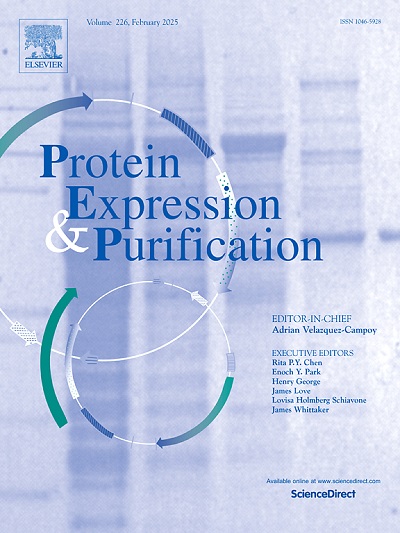重组人 FOXJ1 蛋白可结合 DNA、形成高阶寡聚体、具有凝胶转移结构域并含有内在紊乱区。
IF 1.2
4区 生物学
Q4 BIOCHEMICAL RESEARCH METHODS
引用次数: 0
摘要
叉头盒蛋白 J1(FOXJ1)是哺乳动物初级纤毛从 9+0 结构向运动(9+2)结构转化过程中的关键转录调节因子。我们分离了开放阅读框(ORF)的全长和DNA结合域(DBD)的核苷酸序列,并将其表达到大肠杆菌中,成为6xHis标记的蛋白质。诱导后,DBD 形成包涵体,并用 8 M 尿素溶解。尽管将 6xHis-FOXJ1 蛋白亚克隆到多种表达载体和大肠杆菌宿主菌株中,但仍未发现 6xHis-FOXJ1 蛋白被诱导。为了提高诱导性和可溶性,用谷胱甘肽 S-转移酶(GST)取代了 6xHis 标记,在大肠杆菌 BL21(DE3) 中发现了微弱的诱导作用。GST-FOXJ1 在变性凝胶电泳(AM-DRE)中显示出异常迁移,迁移分子量约为 83 kDa,而不是其计算分子量(Mr)72.4 kDa。它还不稳定,会产生降解产物。用谷胱甘肽 S-转移酶(GST)取代 6xHis 标记以提高诱导性和溶解性,代码优化提高了诱导性,但蛋白质仍显示 AM-DRE,且不稳定。重组蛋白似乎对大肠杆菌细胞有毒性或造成代谢负担,或者一旦产生就容易降解,主要原因是缺乏翻译后修饰(PTM)。一些真核蛋白质在核糖体工厂制造后需要进行这一过程。两种纯化的重组蛋白都表现出半胱氨酸通过形成二硫键诱导的寡聚化,因为使用二硫苏糖醇(DTT)可将其还原。这两种蛋白的功能相同,都能单独与寡核苷酸结合,而寡核苷酸是 FOX 蛋白的一种共识 DNA 结合序列。此外,与 C 端和 N 端相对应的重组多肽显示出异常,表明这些多肽中的高酸性残基(称为多酸性凝胶转移结构域)有助于 AM-DRE。我们首次证明,重组的 HsFOXJ1 及其 DBD 可与 DNA 结合,其多酸性凝胶移动结构域是产生 AM-DRE 的原因,它不稳定,会产生降解产物,表现出半胱氨酸诱导的寡聚化,并含有内在无序区。本文章由计算机程序翻译,如有差异,请以英文原文为准。
Recombinant human FOXJ1 protein binds DNA, forms higher-order oligomers, has gel-shifting domains and contains intrinsically disordered regions
Forkhead box protein J1 (FOXJ1) is the key transcriptional regulator during the conversion of mammalian primary cilium with a 9 + 0 architecture to the motile (9 + 2) one. The nucleotide sequences of the full-length and DNA-binding domain (DBD) of the open reading frame (ORF) were isolated and expressed into E. coli as 6xHis-tagged proteins. Upon induction, the DBD formed inclusion bodies that solubilized with 8 M urea. No induction of 6xHis-FOXJ1 protein was seen despite sub-cloning into several expression vectors and E. coli host strains. To improve induction and solubility, the 6xHis tag was substituted with Glutathione S-transferase (GST), and weak induction was seen in E. coli BL21(DE3). The GST-FOXJ1 showed anomalous migration on denaturing gel electrophoresis (AM-DRE), migrating at approximately 83 kDa instead of its calculated molecular weight (Mr) of 72.4 kDa. It was also unstable and led to degradation products. The 6xHis tag was substituted with Glutathione S-transferase (GST) to improve induction and solubility. Codon-optimization improved the induction, but the protein still showed AM-DRE and instability. It seemed that the recombinant protein was either toxic or posed a metabolic burden to the E. coli cells or, once produced was prone to degradation due mainly to the lack of post-translational modification (PTM). This process is required for some eukaryotic proteins after they are manufactured in the ribosomal factory. Both the purified recombinant proteins exhibited cysteine-induced oligomerization via the formation of disulphide bridges since this was reduced using dithiothreitol (DTT). Both were equally functional as these individually bound to an oligonucleotide, a consensus DNA-binding sequence for FOX proteins. Further, the recombinant polypeptides corresponding to the C-terminus and N-terminus show anomalies indicating that the highly acidic residues (known as polyacidic gel-shifting domains) in these polypeptides contribute to the AM-DRE. We demonstrate for the first time that the recombinant HsFOXJ1 and its DBD bind to DNA, its polyacidic gel-shifting domains are the reason for the AM-DRE, is unstable leading to degradation products, exhibits cysteine-induced oligomerization and harbours intrinsically disordered regions.
求助全文
通过发布文献求助,成功后即可免费获取论文全文。
去求助
来源期刊

Protein expression and purification
生物-生化研究方法
CiteScore
3.70
自引率
6.20%
发文量
120
审稿时长
32 days
期刊介绍:
Protein Expression and Purification is an international journal providing a forum for the dissemination of new information on protein expression, extraction, purification, characterization, and/or applications using conventional biochemical and/or modern molecular biological approaches and methods, which are of broad interest to the field. The journal does not typically publish repetitive examples of protein expression and purification involving standard, well-established, methods. However, exceptions might include studies on important and/or difficult to express and/or purify proteins and/or studies that include extensive protein characterization, which provide new, previously unpublished information.
 求助内容:
求助内容: 应助结果提醒方式:
应助结果提醒方式:


